
bait weight
The intellectual side of me is often intrigued when down at the local live bait mercantile a successful angler opines about the bait they were tossing that day. Typically their long-winded description boils down to a “1/4-ounce plastic shrimp.” While to the blessed bystanders soaking in the counsel this sounds benign enough—it leaves so much to the imagination of the cerebral fishermen.
Mind you, all baits aren’t created equally. Interestingly and oddly enough, some 1/4-ounce baits fish like 1/2-ounce baits while some 1/2-ounce baits fish like 1/4-ounce baits.
Here’s why:
Profile
A bait’s rigging weight, that is, the lead in the rigging quotient, has little relevance as it’s the bait’s hydrodynamic profile which dictates the manner in which a particular bait fishes. While that “hydrodynamic” stuff sounds profound, it’s no more than a $5 word used to describe the amount of surface area and subsequent friction coefficient any particular bait possesses.
For instance, a large-profile bait, such as a DOA shrimp, has more surface area (and larger friction coefficient) than a smaller profile bait, such as a cocahoe grub. As such, a DOA rigged with a 1/4-ounce jig head will sink slower as it is affected by more friction than the more demure cocahoe rigged exactly the same.
Application
Depending on the nature of the day’s bite, bait profile can make all the difference in the world. It’s this profile that dictates the action and thus the presentation. For instance, our large profile DOA shrimp will outshine a cocahoe-style grub when the bite grinds to a drunken crawl. The reason is simple: it’s significantly larger hydrodynamic friction coefficient slows the baits, moving more lethargically—inducing more strikes than it’s faster moving (with its smaller friction coefficient) cocahoe counterpart.
Buoyancy
Another much overlooked bait weight consideration is the buoyancy of the materials our plastic imitator is poured with. Ever notice while playing with slimy plastic baits in the packaging at a local retailer some are more supple (i.e., “squishy”) than others? It’s because each is poured with a different “formula.” Some manufacturers add more plastic softener for a supple bait feel, while others minimize this commodity so they have a rugged bait.
As each bait’s profile matters, so does its buoyancy as dictated by the plastic recipe. Typically speaking, softer plastic baits (less dense) are more buoyant and float higher. Conversely, more dense, harder plastics tend to sink quicker.









